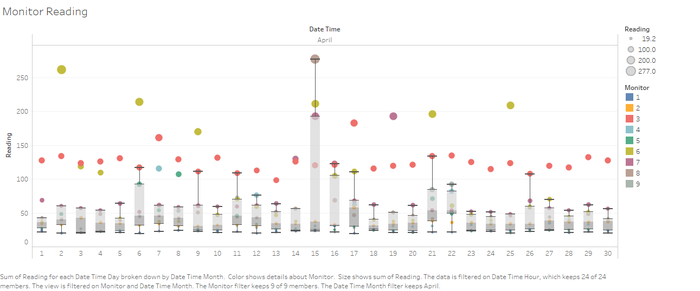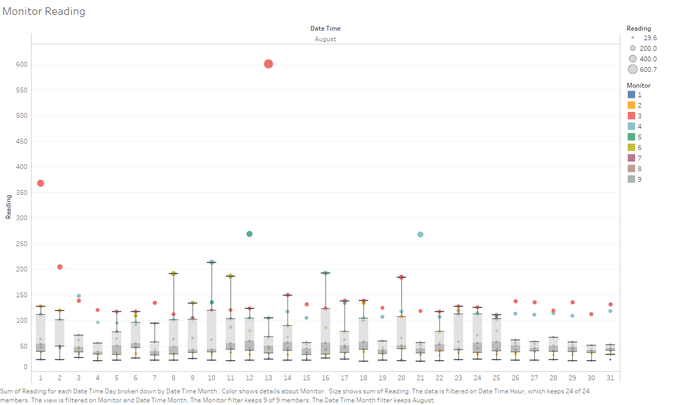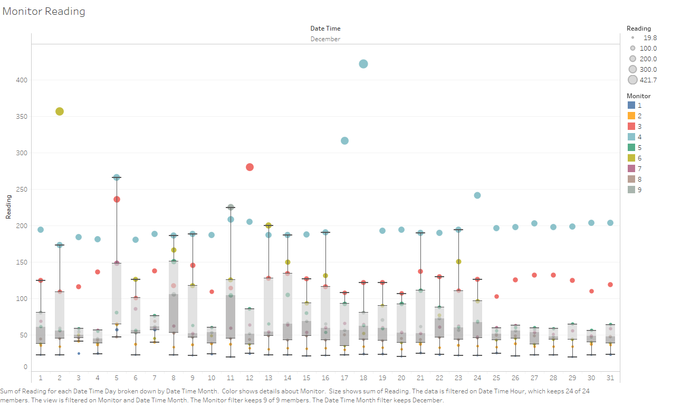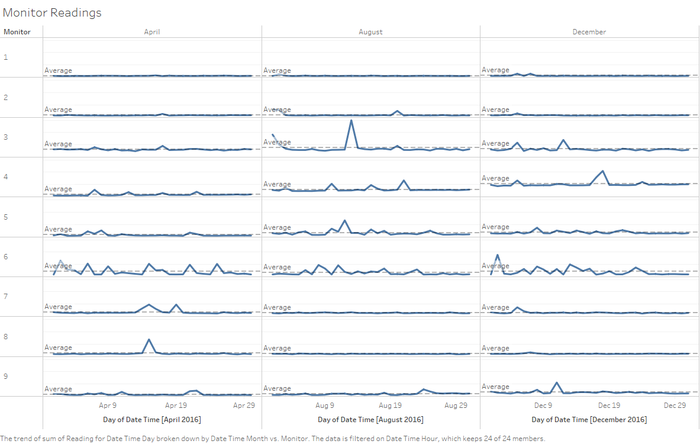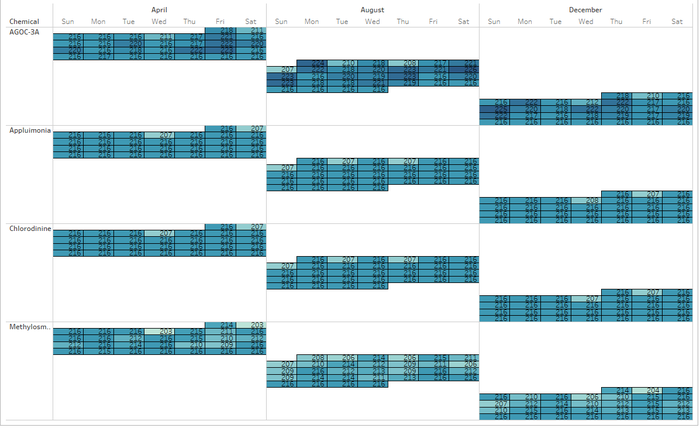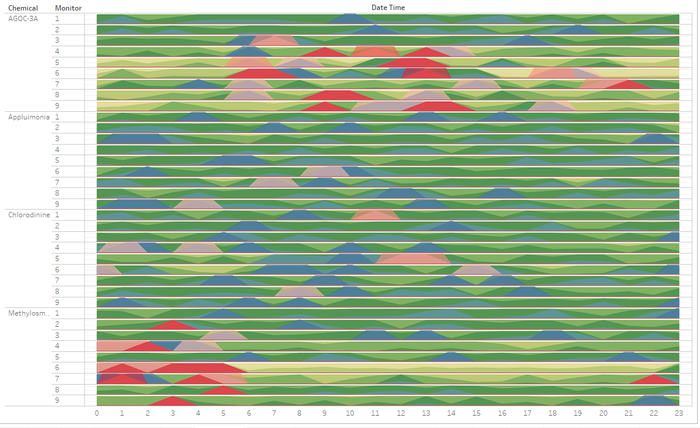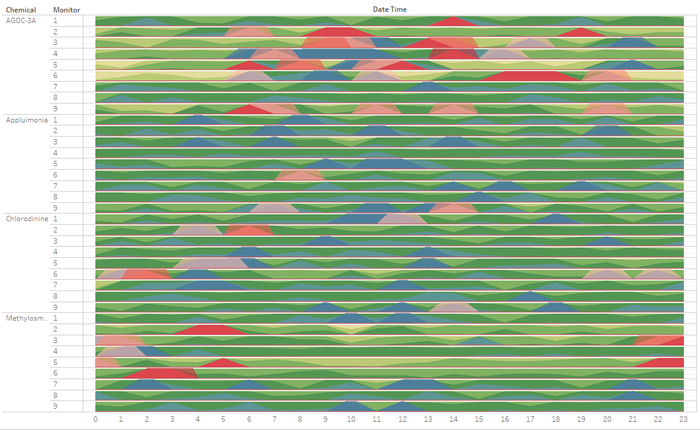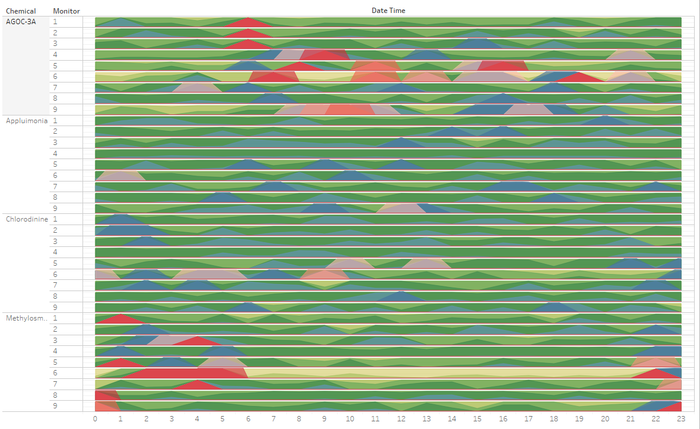ISSS608 2016-17 T3 Assign DEBASISH BEHERA conclusion
|
|
|
|
Tableau Public:
Question 1
Characterize the sensors’ performance and operation. Are they all working properly at all times? Can you detect any unexpected behaviors of the sensors through analyzing the readings they capture?
Month: April From the figure, monitor 3 and monitor 6 are consistently showing very high readings every day.
When we analyse the readings of all the monitor it shows that all the monitors are not showing proper reading at all the times of the day.
Month: August We notice that the readings are very high for the monitor 3,4 and 6. Monitor 3 is the one with the highest readings.
Month: December We notice that very high readings are showing for monitor 3,4 and 6. Monitor 4 is showing the highest reading.
Now we look at the no of readings picked up by each of the sensors around the factory vicinity to find out why the readings are very high on certain months.
From the above figure, it is evident that the readings from monitor 3,4, 5 and 6 are consistently showing more than average readings throughout the 3 months’ period whereas monitor 1, 2 and 9 are showing consistent readings. Also, if we consider the readings of 7 and 8 there is some spike in the month of April but no spikes in the month of August and December.
Now let us see what are the no of records that are captured by each of the sensors since they should capture mostly equal no of readings.
From the readings obtained for the month of April, August and December it seems that whenever there is an increase in readings of chemical AGOC-3A there is a decrease in the readings of the chemical Methylosmolene. Conclusion: From the reading value and number of readings recorded it seems that Sensor 7 and 8 were showing different readings for the month of april for AGOC and Methylosmolene but in the month of August and December the readings were constant. For the sensors 3,4,5,6,9 the no of readings recorded by them seems to change a lot especially for the month of August whereas the no of readings from sensor 1 and 2 varies very little.
Question 2
Which chemicals are being detected by the sensor group? What patterns of chemical releases do you see, as being reported in the data?
From the calendar plot we get some interesting insights from it. We notice that the number of records for the month of April is low for every chemical reading on the 2nd and 6th of the month. For august it is getting repeated for the 2nd,4th and 8th of the month For December, there is no peculiar pattern that we can find. In December, the chemical readings are changing for the 2nd and 7th of the month. Now let us see the readings of the chemicals throughout the different monitor readings.
April:
AGOC-3A- monitor/sensor 4,5,6,8,9 are the group of monitors that are showing very high spikes in terms of readings mainly between 05:00 AM to 02:00 PM. Sensors 1 and 2 captures most of the readings throughout the day. Appluimonia- Monitor/sensor 6,7 and 9 are the groups of sensors that are showing very high spikes in readings. Chlorodinine-1,4,5,6,8 are the sensors group that captures most of the reading during 12:00 AM to 03:00 AM. Sensors 1,2,8 are able to capture the readings throughout the day. Methylosmolene-1,2,3,8 are the sensors that capture most of the readings throughout the day with sensors 4,6,7,8 showing high spikes only in the morning hours. Here we have to see whether this pattern exists throughout rest of the months as well.
August:
AGOC-3A- sensors 3,4,5,6 captured very high readings for this chemical between 5:00 AM to 4:00 PM Appluimonia -2,3 and 9 are the sensors that captured this chemical reading. Chlorodinine-sensors 3,4,8 and 9 captured most of the readings of this chemical Methylosmolene-1,8,9 are the sensors that captured most of the readings here. Whereas some spikes were observed by the sensors 2,5 and 6 during the time 12:00 AM to 6:00 AM
December:
AGOC-3A- Here the sensors 1,2,3 shows spikes in the readings at 6:00 AM where as the sensors 4,5,6 are picking up very high spike in the readings. Appluimonia – sensor 6 and 7 show high readings . Chlorodinine- sensor 5 and 6 here are showing some high readings. Methylosmolene-1,3,5,6,8,9 observed very high spikes in the readings during the night hours which seems to suggest that this chemical which is banned and most dangerous of all the chemicals are being released by the factory during the night hours. In our case, we observe the spike in the readings from 10:00 PM to 6:00 AM This trend is similar to the high spikes that was observed in the month of April. Also, it seems that this particular chemical shows spike in the morning hours but no spike between 6:00 AM to 10:00 PM which may suggest that the factories may have been neutralizing the chemical after 6:00 AM but at night they may not be doing so.
Question 3
Which factories are responsible for which chemical releases? Carefully describe how you determined this using all the data you have available. For the factories you identified, describe any observed patterns of operation revealed in the data.
We will be looking into this chemical wise:
AGOC-3A:
sensor 5:

